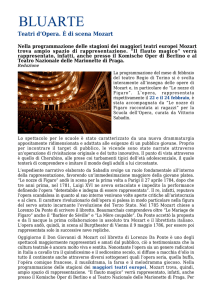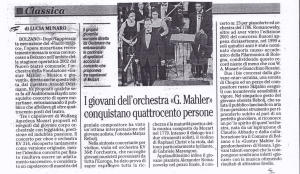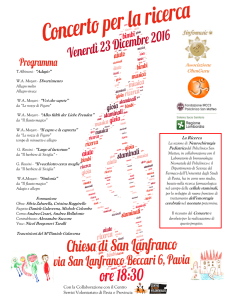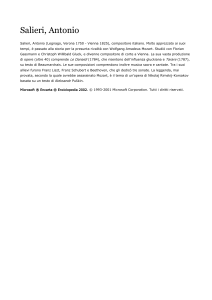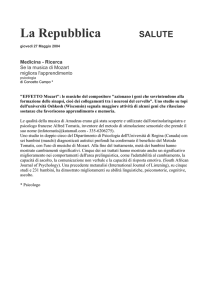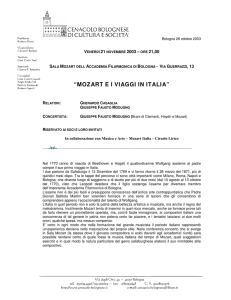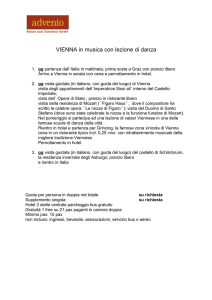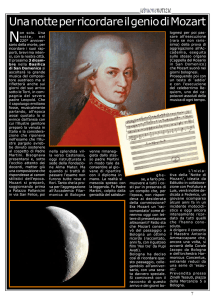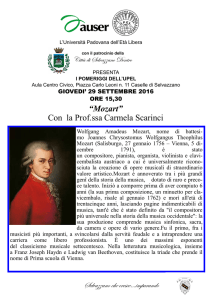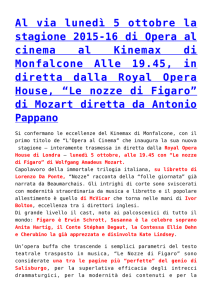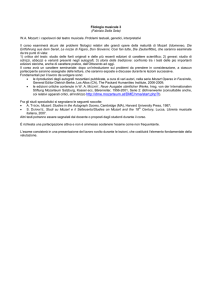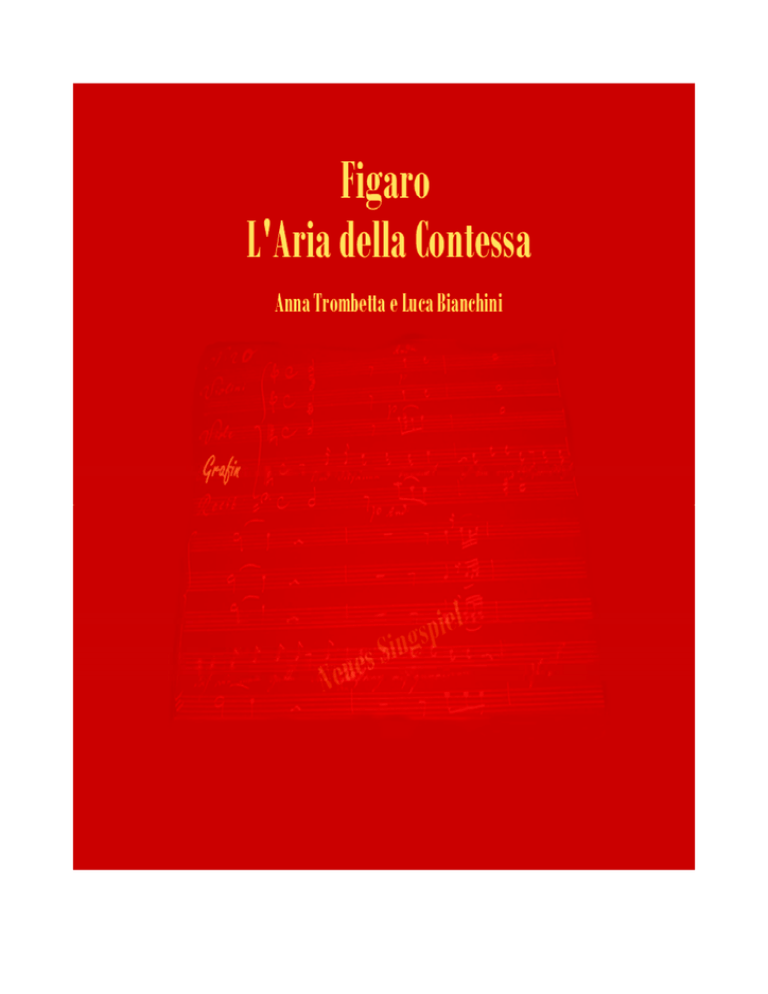
Figaro
L’ARIA DELLA CONTESSA
Introduzione storica, Analisi dei manoscritti e Revisione
Anna Trombetta e Luca Bianchini
Free Translation with Additional Comments and Footnotes
Robert E. Newman
Il compito degli uomini di cultura è più che mai oggi quello
di seminare dei dubbi, non già di raccogliere certezze.
The task of cultured people, especially nowadays,
is to raise doubts and not to collect certainties.
Norberto Bobbio
A nostra figlia Erika
Questo nostro studio che ci ha impegnato per alcuni mesi non sarebbe stato
possibile senza il contributo di tre cari amici che ringraziamo: il prof. Giorgio
Taboga e suo figlio Agostino Taboga per averci fornito i microfilm dei
manoscritti della Biblioteca di Vienna e per essere stati disponibili a confronti
e chiarimenti. Prezioso per noi è stato l’aiuto del prof. Robert Newman che
con pazienza e competenza ha proposto una traduzione libera del testo
introduttivo storico per i lettori inglesi, traducendo invece in modo letterale la
parte dell’analisi dei manoscritti.
Gli autori
Sondrio, 12 giugno 2008
To our daughter Erika
This study, which has occupied us for some months, would be not have been
possible without the help of three of our dear friends whom we wish to thank
here - Professor Giorgio Taboga and his son Agostino Taboga, providing
microfilms from the Austrian Library in Vienna and for being so helpful in
sharing ideas and for clarifying a whole series of matters. Also Robert
Newman who with patience and timely suggestions has helped to realise the
free translation of the historical introductory text in English for both general
and expert readers and a literal English translation for the musical analysis of
these manuscripts.
The Authors
Sondrio, 12th of June 2008
Indice
Index
Introduzione storica (testo italiano)
Historical background (English text)
pag. 6
pag. 18
Analisi delle fonti - Analysis of Manuscript Sources
(testo italiano e inglese / Italian - English text):
Da NMA a MS “A” / From NMA to MS “A”
pag. 38
Da MS “A” a NMA / From MS “A” to NMA
pag. 68
Conclusioni / Conclusion
pag. 101
Bibliografia e Sitografia
Bibliography and Sitography
pag. 112
Trascrizione inedita del Recitativo e dell’Aria della Contessa:
Unpublished Transcription of the Recitative and Aria of the
Countess:
Versione A di Vienna, The Vienna Version A (KT315)
Versione B di Vienna, The Vienna Version B (KT315)
Versione C di Modena, The Modena Version C (F791)
pag. 115
pag. 147
pag. 186
INTRODUZIONE STORICA
Le notizie intorno alla progettazione delle Nozze di Figaro, al lavoro creativo di
Wolfgang Amadé Mozart e di Lorenzo Da Ponte e alla committenza dell’opera sono
scarse.
“L’epistolario di Mozart presenta proprio per questo periodo, una notevole lacuna lamenta Edward Dent - e la nostra principale fonte d’informazione è il pettegolo
tenore irlandese Michael Kelly, che era stato da poco scritturato all’Opera Italiana di
Vienna. … Ma Kelly, come Da Ponte, pose mano alla stesura delle proprie memorie
quando Mozart era già un classico riconosciuto, ed era naturalmente preoccupato di
porre nella miglior luce i suoi rapporti con lui.”1
È davvero inspiegabile il silenzio di Mozart sulle Nozze di Figaro, la prima
importante opera buffa che ha realizzato in collaborazione col librettista italiano Da
Ponte. Mancano in questo caso le lettere indirizzate al padre e sembra che il musicista
non sia più interessato a comunicargli i progressi della sua composizione, mentre
poco prima, all’epoca della realizzazione del Singspiel Die Entführung aus dem
Serail o dell’abbozzo per L’oca del Cairo continuava nella fitta corrispondenza a
richiedergli pareri.
In assenza di notizie di prima mano da parte del compositore non ci resta che
ricorrere a testimonianze indirette per chiarire le fasi della realizzazione dell’opera.
Il 31 gennaio del 1785 Giuseppe II scriveva al conte Pergen:
“Apprendo che la nota commedia Le mariage de Figaro è stata proposta in
traduzione tedesca per il Teatro di Porta Carinzia. Ora siccome questa pièce contiene
molte indecenze ritengo che il censore la debba rifiutare del tutto, oppure vi debba
apportare ritocchi tali ch’egli possa assumersi la responsabilità della rappresentazione
e dell’effetto che essa starà per fare.”2
Con queste parole l’imperatore aveva bloccato l’esecuzione affidata alla compagnia
di Emanuel Schikaneder programmata per il 3 febbraio 1785 al Teatro di Porta
Carinzia, gestito dalla corte imperiale, mentre la censura aveva permesso la stampa
del testo. Infatti nel Wienerblätter del 2 febbraio 1785 si legge: “Il sig. Rautenstrauch
ha recentemente tradotto in tedesco la commedia Les Noces de Figaro accolta con
strordinario successo a Parigi. Sarà eseguita per la prima volta domani dalla
compagnia dei signori Schikaneder e Kumpf” e il 4 febbraio si avvisa che “la
commedia promessa da Emanuel Schikaneder Die Hochzeit des Figaro non è stata
eseguita ieri e secondo la notizia diffusa dal manifesto di ieri la censura ha
autorizzato che sia stampata, ma non rappresentata.”3
Ancor prima che Mozart e Da Ponte iniziassero ad elaborare la versione italiana delle
Nozze e nonostante il divieto, era stato già rappresentato a Francoforte l’11 aprile
1
Edward J. Dent, Il teatro di Mozart, Rusconi, Milano 1979, pag.144-145.
Rudolf Payer von Thurn, Joseph II als Theaterdirektor, Wien-Leipzig 1920, pag.60 cit. in Giorgio Taboga,
Mozart una morte violenta, Arché, Milano, 2008, pag. 75, vedi anche Otto Erich Deutsch, Mozart: A
Documentary Biography, Stanford University Press, Paolo Alto, 1965, pag.235.
3
Otto Erich Deutsch, Mozart: A Documentary Biography, Stanford University Press, Paolo Alto, 1965,
pag.235.
2
FIGARO - ARIA OF THE COUNTESS
LUCA BIANCHINI AND ANNA TROMBETTA
Free translation with additional comments and footnotes
Robert E. Newman
Hard information on the formative history of the opera ‘Le Nozze di Figaro’
(premiered on 1st May 1786 and staged to far greater acclaim by the Pasquale Bondin
stage company that same December in Prague) is remarkably scarce. Just as scarce
are meaningful details of collaboration between Wolfgang Amade Mozart and
Lorenzo Da Ponte on its creation and on the timescale in which it was created.
‘The Mozart documentation for this period is really a remarkable gap’ complains
Edward Dent ‘Our main source of information on these matters is paltry indeed - it comes almost
entirely from the gossipy Irish tenor, Michael Kelly, who wrote little on Italian opera
in Vienna as such. Kelly, like Da Ponte, wrote long after Mozart was dead and long
after ‘Figaro’ had become a recognized classic, taking special care to place himself
in the best possible light as regards his working relationship with Mozart’. 41
So much for ‘received wisdom’ on the formative history of one of the most famous
and one of the most important operas in all of music. Even when we look more
closely we are met with only profound and enigmatic silence from Mozart himself
and from other contemporary sources on the creation of this work.
Such a silence extends across the centuries and is just as real a factor in countless
modern musicological publications. Da Ponte’s generalized and all too brief
statements on Figaro (written many years later and long after the time of Mozart‘s
death) are little more than models of obfuscation and are even in various respects
contradictory. Both men seem strangely reluctant to provide meaningful details of
what must have been a remarkable chapter in both their creative lives. Equally
strange is that letters from Wolfgang to Leopold during this period show him
strangely disinclined to provide details of Figaro’s birth or to refer to the problems
and the challenges he must surely have faced. So very different from the days of Die
Entfuhrung aus dem Serail, from those of Idomeneo in Munich and from making the
first draft of L’Oca del Cairo. Details are missing from Mozart about Figaro and
from those around him concerning such matters as the commission of the piece,
meetings, general and specific plans for its realization or the things we reasonably
expect to exist from a composer and librettist who are busy turning Europe’s most
famous/notorious play in to a major Viennese opera. Such problems thwart attempts
to arrive at a sustainable understanding of the genesis of this work. This puzzling
41
Edward J Dent - ‘The Theatre of Mozart’ - Rusconi, Milan, 1979, pp. 144-5
ANALISI DELLE FONTI: DA NMA A MS “A”
ANALYSIS OF THE MANUSCRIPT SOURCES: FROM NMA TO MS “A”
La versione NMA
The NMA version
Iniziamo l’analisi prendendo in esame
l’edizione moderna del Recitativo e
dell’Aria dell’Atto III scena VIII
pubblicata in NMA, evidenziando i punti
di criticità riscontrati nel libretto e nella
musica.
Il testo dell’Accompagnato della Contessa
come si legge in NMA è problematico,
perché presenta incongruenze formali e
logiche. Ad esempio i versi
We begin our analysis by taking into
consideration the modern edition of
this same Recitativo and Aria in Act III
Scene VII as found in the current
edition of NMA Figaro and showing the
various points in this libretto and music
where there are problems. We find the
text of the Accompagnato of the
Countess in the current version of Neue
Mozart-Ausgabe (NMA) is itself highly
problematic for it contains a number of
logical and formal discrepancies. For
example the lines -
Alquanto ardito il progetto mi par e ad uno
sposo sì vivace e geloso!
very daring this project appears to me and
to a bride so lively and jealous !
non hanno alcun senso dal punto di vista
sintattico, mentre
are from a language point of view
nonsensical, both syntactically and
grammatically. And also -
fammi or cercare da una mia serva aita!
let me search for a help from my servant
è una frase sconclusionata, se letta nel
contesto e collegata ai versi che la
precedono:
is a text without sense when we consider
the context that was already given in the
previous lines -
Ma che mal c'è?
Cangiando i miei vestiti
Con quelli di Susanna, e i suoi co' miei...
Al favor della notte... oh cielo, a quale
Umil stato fatale io son ridotta
Da un consorte crudel, che dopo avermi
Con un misto inaudito
D'infedeltà, di gelosia, di sdegni,
Prima amata, indi offesa, e alfin tradita,
Fammi or cercar da una mia serva aita!
But where’s the harm?
To change my clothes
With those of Susanna, and hers with
mine,
Under cover of darkness… Oh heavens!
To what Fatal condition am I reduced
By a cruel husband who after having
In a strange mixture
Of infidelity, jealousy and disdain,
First loved me, then neglected and finally
deceived me
Let me search for a help from my servant!
DA MS “A” A NMA
FROM MS “A” TO NMA
La versione MS “A”
The MS “A” version
La nostra analisi comincia stavolta da MS Our analysis begins this time with
“A”, che è la versione in forma di
document MS “A” - the version of
Singspiel, come si vede nella fig.18:
Figaro from Vienna that exists in the
form of a German Singspiel as you can
see from the following picture fig.18
fig.18
La scena è la VII e il numero
dell’Accompagnato è il 20. Si notano il
testo tedesco in alto a sinistra e la
musica nel foglio a destra col
Recitativo. C’è un testo a sinistra e ci
sono delle aggiunte sottostanti in
differente grafia dopo la “X”. Anche
“Contessa”, ossia “Grafin” che si legge
nella pagina destra qui sopra, è stato
inserito in un secondo tempo. Il
Recitativo accompagnato in origine
non aveva il nome del personaggio.
Torniamo alla pagina sinistra: alla terza
riga in alto c’è un’altra piccola “x”, che
The specific scene under examination here
is given as ‘’VII’’ and the number
of the Accompagnato is given as “20”. You
will notice at once that the German text is
given above on the left and its music is
found in the sheet on the right on which is
also found the Recitativo. There is also text
on the left as you see and under this text are
parts added in a different calligraphy after
an “X”. You can also see written,
“Countess” i.e. “Grafin” on the left page in
the previous picture, which seems to have
been added almost as an afterthought. (The
Accompagnato had previously not
Anna Trombetta e Luca Bianchini sono
musicisti e musicologi, laureati con lode alla
Scuola di Paleografia e Filologia Musicale di
Cremona.
Da anni revisionano opere musicali, eseguite in
prima mondiale e registrate in CD, tra l'altro
l’Armida Immaginaria di Cimarosa per il Teatro
di Montpellier e per il Festival Internazionale
della Valle d'Itria, la Medea di Pacini per il
Teatro di Savona, trasmessa da RAI 3, replicata
nel 2006 nel Teatro Antico di Taormina, In
Filanda di Pietro Mascagni per il Teatro
Mercadante di Napoli, gli Oratori di Zingarelli,
le Sinfonie di Donizetti, la Dorilla in Tempe di
Vivaldi, oltre a numerose opere inedite, concerti,
musica cameristica e sacra di Giovanni Pacini e
Johann Simon Mayr.
Hanno scoperto a Milano il primo Werther in
forma operistica, opera sconosciuta di Johann
Simon Mayr, registrato in CD Bongiovanni e
trasmesso dalla Radio nazionale tedesca.
Collaborano col Paisiello Festival di Taranto e
con Case discografiche ed editrici musicali.
Hanno scritto tra l’altro il libro Goethe, Mozart e
Mayr fratelli Illuminati, Archè, Milano 2001 con
prefazione di Alberto Basso; la monografia
Teresina Tua l’angelo del violino, Daniela
Piazza Editore, Torino 2006, presentata in
edizione scenica al Piccolo Regio e al
Conservatorio “Giuseppe Verdi” di Torino;
l’edizione critica dell’opera in due Atti Toberne
o il Pescatore Svedese di Bartolomeo Bruni,
LIM editrice, Lucca 2007, con introduzione di
Alberto Viarengo e pubblicato articoli, saggi,
note di copertina e centinaia di spartiti e partiture
orchestrali.
Anna Trombetta and Luca Bianchini are both
musicians and musicologists with a Ph.D ‘cum
laude’ in Musicology at the University of Music
Palaeography and Philology of Cremona. For
many years they have revised musical works for
their first world performances and recordings.
For example Cimarosa’s ’Armida Immaginaria’
for the Theatre of Montpellier and for the
International Festival of Valle d’Itria. Also
’Medea’ by Pacini for the Theatre of Savona,
broadcast by RAI 3 and repeated in 2006 at the
Theatre of Taormina. Also ’In Filanda’ by Pietro
Mascagni for the Theatre Mercadente in Naples,
Oratorios by Zingarelli, the Symphonies of
Donizetti, ’Dorilla in Tempe’ by Antonio
Vivaldi and numerous unpublished stage works,
concertos, chamber and sacred music by such
composers as Giovanni Pacini and Johann Simon
Mayr. They were first to discover in Milan the
first ‘Werther’ ever written in operatic form, this
composed by Johann Simon Mayr and recorded
on CD by Bongiovanni and broadcast by
national German Radio. They have also
collaborated with the Paisiello Festival in
Taranto and with various discographical
industries and music publishers. They have
written various books and publications including
‘Goethe, Mozart e Mayr fratelli Illuminati‘,
Archè, Milano 2001 with a preface by Alberto
Basso; the monograph ‘Teresina Tua l’angelo del
violino‘, Daniela Piazza Editore, Torino 2006,
performed on stage at Piccolo Regio and at
Conservatorio “Giuseppe Verdi” in Turin; the
critical edition of the opera in two Acts Toberne
o il Pescatore Svedese by Bartolomeo Bruni,
LIM editrice, Lucca 2007, with introductory
comments by Alberto Viarengo and have
published articles, essays, cover notes and
hundreds of vocal and orchestral scores.
Robert Newman è nato a Dunfermline in
Scozia. Ha studiato musica negli anni 1970 alla
Royal School of Music di Londra. È stato
musicista professionista per 5 anni, e poi s’è
dedicato allo studio della musica antica e
moderna. Dopo la carriera in campo
amministrativo, è tornato ad occuparsi della
ricerca musicale, in particolare della musica del
XVIII secolo. Interviene spesso nei forum di
musica e da nove anni sta lavorando a una
biografia di Mozart, di imminente pubblicazione.
Robert Newman was born in Dunfermline,
Scotland, and studied music at the Royal School
of Music in London in the 1970's. He was a
professional musician for 5 years who later
studied ancient and modern music. A career in
legal/contract administration was followed by
him returning to research and write on music of
the 18th century. He is a frequent contributor to
various online music forums and has been
researching/working for almost 9 years on a
forthcoming Mozart biography.

